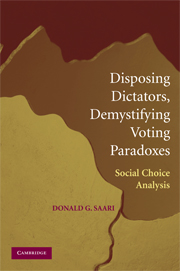5 - Deliver Us from the Plurality Vote
Published online by Cambridge University Press: 24 May 2010
Summary
To connect theory with reality, this concluding chapter addresses certain realistic, pragmatic dangers associated with actual elections. I also critique, but only briefly, some contemporary, so-called reform efforts.
After exhibiting my tendency toward reckless behavior by sticking a toe into the dangerous waters populated by advocates of various voting rules, I will hastily retreat to the safety zone ensured by theory and academics. Once back in this ivy-covered haven, I will tie together certain points made in this book by using a different approach.
Our Standard Voting Rule
The material developed in the past few chapters probably spawned worries about the accuracy of standard elections. I hope so; a strong, take-home message is that standard voting rules create real and grave problems.
These fears realistically arise whenever elections are based on, or involve, the plurality vote. As described in the past two chapters, this typically used voting rule suffers severe weaknesses causing its outcomes to compromise the wishes of the voters. To escalate the rhetoric, it is realistic to fret about the legitimacy of any reasonably close election where the outcomes involve the plurality vote.
The 2000 U.S. Presidential Election
In Section 1.1, doubt was expressed whether the 2000 U.S. presidential election outcome involving George W. Bush, Albert Gore, and Ralph Nader accurately reflected the views of the voters.
- Type
- Chapter
- Information
- Disposing Dictators, Demystifying Voting ParadoxesSocial Choice Analysis, pp. 190 - 217Publisher: Cambridge University PressPrint publication year: 2008

